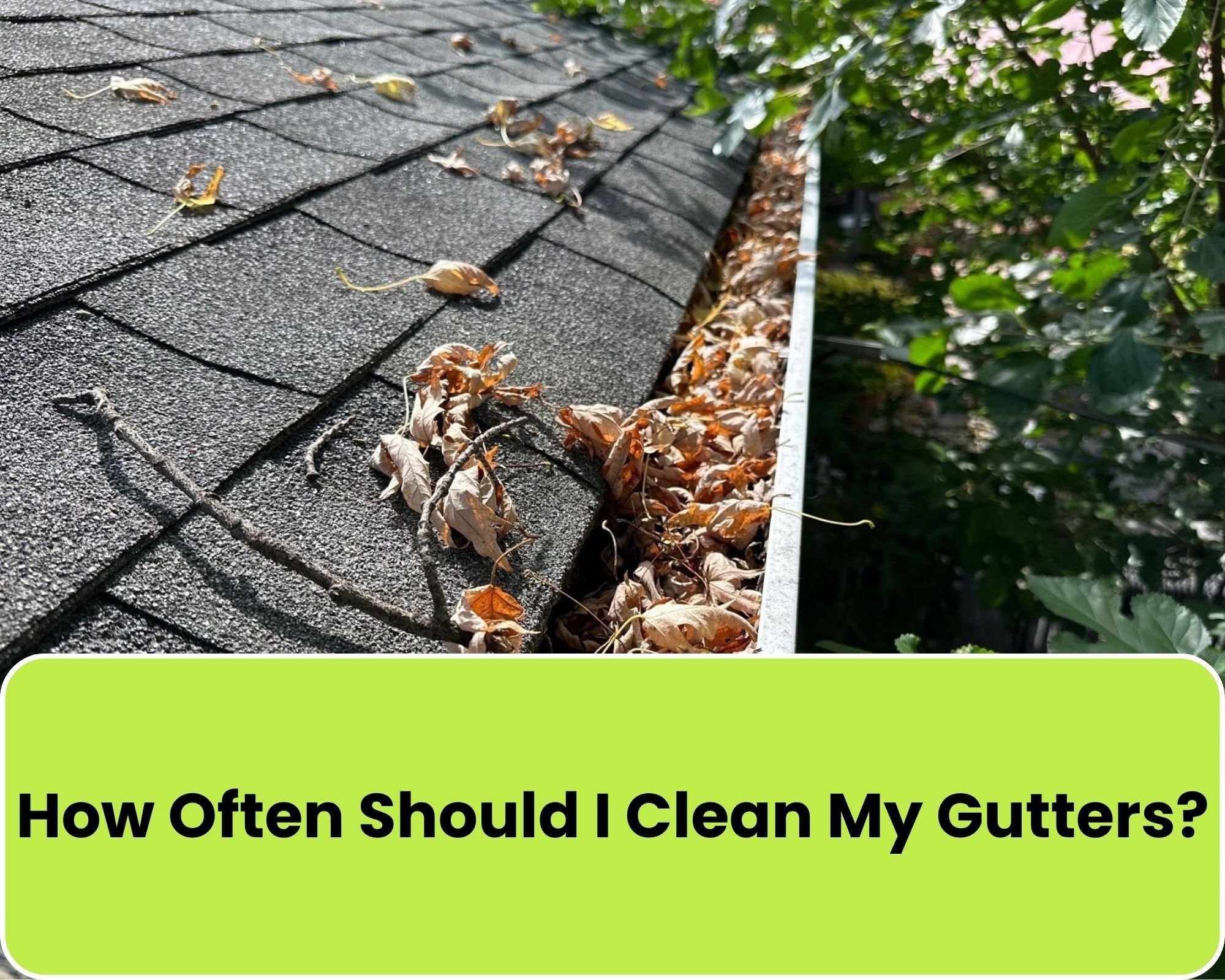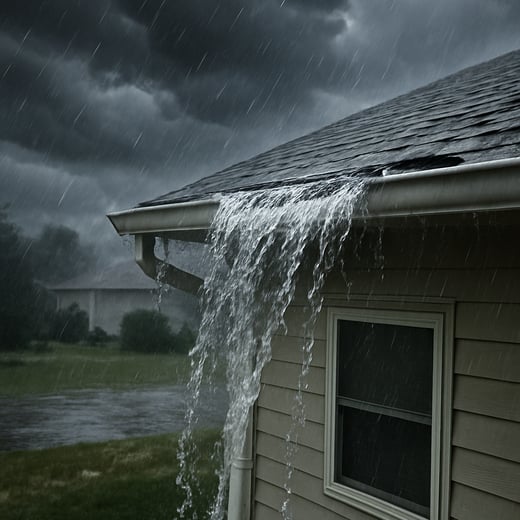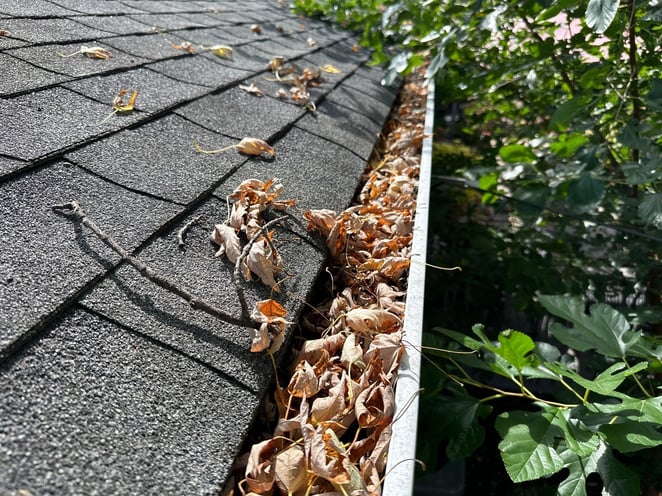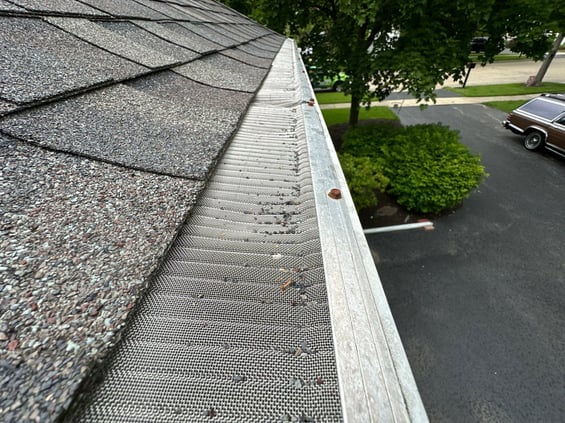How Often Should I Clean My Gutters? — Gutter Maintenance 101

It's easy to forget about your gutters until you're dealing with a flooded basement, rotting fascia, or a surprise leak after a heavy storm. What looks like just a bit of leaf buildup can quietly cause thousands in damage if left unchecked.
Gutter cleaning is one of the most important maintenance tasks for protecting your home and roof.
At Happy Roofing, we've seen what happens when gutter maintenance gets neglected. Sagging, clogged, or poorly installed gutters can lead to water seeping behind the fascia, siding, and basement.
In this article, you'll learn:
- What can happen if gutter maintenance is skipped
- How often gutters should be cleaned
- How to prevent your gutters from getting clogged
Let's break down the basics of gutter maintenance so you can protect your home from costly water damage.
Table of Contents
- What Happens When Gutters Aren't Cleaned Regularly?
- How Often Gutters Should Be Cleaned
- Can You Clean Your Gutters Yourself?
- How Much Professional Gutter Cleaning Costs
- How to Prevent Gutters From Clogging
- When to Replace Your Gutters
What Happens If You Don't Clean Your Gutters?
If you don't clear your gutters of debris, water won't drain properly. That can lead to serious damage to your fascia (the board that supports the gutters), siding, foundation, and even your landscaping.
Gutters are designed to move water away from your home, but when they're clogged with leaves or other debris, that water has nowhere to go. It starts backing up, flowing over the sides of the gutter, and pooling in areas where you don't want water (like around your foundation).
Here's what can happen when gutters are neglected:
- Poor drainage: Clogged gutters trap water at the edge of your roof and can penetrate the fascia or siding, or spill over the edge of the gutters.
- Foundation and basement damage: Overflowing water spills down the exterior of your home, saturating the soil and putting pressure on your foundation. This can lead to basement leaks or foundational cracks over time.
- Gutter system failure: The added weight of debris and trapped water can cause gutters to sag, pull away from the house, or even collapse.
- Ice dams in winter: In colder climates, clogged gutters can trap melting snow, which then refreezes at the roof edge and creates ice dams that can lift shingles and force water under your roof. Conditions have to be right for this to happen, as the melting snow needs to refreeze relatively quickly, but clogged gutters increase the possibility of ice dams.
- Pest and mold issues: Stagnant water and decaying leaves make ideal breeding grounds for mosquitoes, birds, and mold growth near your roofline.
Regular gutter cleaning is a good preventative measure to avoid these issues, allowing water to drain away from your home as it was intended. Below is a photo demonstrating how water can overflow if gutters are clogged:

How Often Should You Clean Your Gutters?
In most cases, you should clean your gutters at least twice a year, once in the spring and once in the fall. This standard frequency helps prevent clogs from seasonal debris and protects your home from potential water damage.
However, depending on your property and environment, some homes may need more frequent cleaning.
Factors That Affect How Often You Should Clean:
- Nearby trees: Homes surrounded by trees (especially pines or hardwoods) may require more frequent cleaning as falling leaves, needles, and twigs can quickly clog gutters.
- Roof type and slope: Certain roof styles shed debris more efficiently, while flat or low-slope roofs may trap more material that ends up in your gutters.
- Storm frequency: If you live in an area prone to heavy rains or windstorms, you may need to inspect and clean gutters more often to check for any debris that may have blown into the gutter system.
- Pest issues: If you've dealt with birds, rodents, or insects nesting in your gutters, more frequent inspections can help catch future problems early and ensure no debris blocks the flow of draining water.
You want to avoid letting leaves and other debris build up to the point where water can't flow freely, like in the picture below:

Can You Clean Gutters Yourself?
Many homeowners can safely clean their gutters themselves, especially on single-story homes with easy roof access. DIY gutter cleaning can save money and give you firsthand insight into your roof's condition, but it's not always the safest or most efficient choice in certain situations.
If you have a taller home, a complex roof design, or if gutter access is difficult, it may be worth calling a roofing professional to clean and inspect your gutter system.
If you decide to DIY, here are some tools that may help you clear your gutters of debris:
- A sturdy extension ladder (and someone to stabilize it)
- Work gloves
- Gutter scoop or trowel
- A bucket or tarp for debris
- Garden hose to flush the system for stubborn debris
Always prioritize your safety, never lean over the edge of a ladder, and avoid working in wet or windy conditions.
Consider hiring a professional if:
- Your home is two stories or taller
- The roof has a complex design with a lot of gutters
- You have mobility or balance concerns
- You want an inspection for damage, leaks, or gutter alignment while cleaning
At Happy Roofing, we offer gutter cleaning because we know how important well-functioning gutters are when it comes to protecting your home. It's also a great opportunity to assess the overall health of your gutter system while ensuring everything is functioning as it should.
How Much Does Professional Gutter Cleaning Cost?
Most homeowners can expect to pay between $100 and $250 for professional gutter cleaning, depending on the size and height of the home.
Here's how home size and design can affect cost:
- Single-story homes: Typically cost around $100–$175 for a full cleaning.
- Two-story homes: Generally run between $150–$250.
- Larger or more complex homes: With steep roofs, lots of gutter footage, or excessive buildup, you may see prices go above $250.
Can You Prevent Gutters From Getting Clogged?
You can't eliminate gutter cleaning entirely, but you can dramatically reduce clogs and maintenance needs with a few preventative steps. Installing gutter guards and routine inspections can go a long way when it comes to the health of your gutter system.
Here are the most effective ways to prevent clogged gutters:
Install Gutter Guards
Gutter guards are designed to keep leaves, twigs, and debris out while letting water pass through. This effectively reduces the amount of buildup that can accumulate in the gutters.
There are several types of gutter guards:
- Mesh screens: Perforated metal or plastic covers that sit on top of the gutter and block larger debris like leaves and twigs while allowing water to pass through. These are affordable and commonly found, but their designs and effectiveness vary widely.
- Micro-mesh guards: Fine stainless steel or aluminum mesh that filters out even small debris like pine needles and roof grit. This style is one of the most effective options for clog prevention.
- Surface tension systems (or reverse curve): These cover the gutter completely, allowing water to flow over the edge and into a narrow slot while leaves slide off the edge. These gutter guards are effective, but are also more expensive and visible.
- Brush inserts: Cylindrical bristle brushes that sit inside the gutter and catch debris while letting water flow through the center. While inexpensive and easy to install, they require more frequent cleaning.
While no system is maintenance-free, a well-installed guard can reduce how often you need to clean your gutters. Even with guards, it's still important to check gutters once a year to ensure they're flowing properly and free from buildup at corners or seams.
Below is an example of how a micro-mesh gutter guard keeps debris from accumulating in your gutter system:

Trim Back Overhanging Tree Limbs
If you have trees near your roof, especially maples, oaks, or pines, regularly trimming back tree limbs will significantly reduce the amount of debris that falls into your gutters. It also lowers the risk of branches scraping shingles, clogging downspouts, or creating shady, damp conditions that promote moss and algae growth.
Regular Gutter Inspections
It's a good habit to inspect your gutters every spring and fall. This gives you a chance to check for any debris caught during the winter, and to clear the leaves from fall. Look for visible clogs, sagging sections, or signs of water building up.
Catching issues early helps prevent damage to your roof and foundation.
When Should You Replace Your Gutters?
Depending on the material, a well-maintained gutter system can last anywhere from 15-50 years. While you don't always need to replace them during a roof replacement, it's the perfect time to evaluate their condition. Ensuring your gutter system works effectively with your new roof can prevent costly problems down the road.
If you're wondering whether your next roof replacement should include a gutter update, check out our guide: Should You Replace Your Gutters at the Same Time as a Roof Replacement? It breaks down when replacement is necessary, when it can wait, and how to avoid paying for something you don't actually need.
If you're unsure about the state of your gutters or roof and want to talk to a professional, we offer no-commitment inspections. We'll provide you with clarity and explain your options, without any obligation to schedule any work.
The Author: Pedro Toledano
Happy Roofing is a trusted roofing company dedicated to providing top-quality roofing services to residential and commercial clients. With years of experience, they specialize in roof installations, repairs, and maintenance, ensuring durability and customer satisfaction. The team is known for their professional approach, timely service, and attention to detail. Happy Roofing prides itself on using high-quality materials and offering competitive pricing. Follow their Facebook page for updates on projects, customer testimonials, and tips on maintaining your roof in excellent condition.





